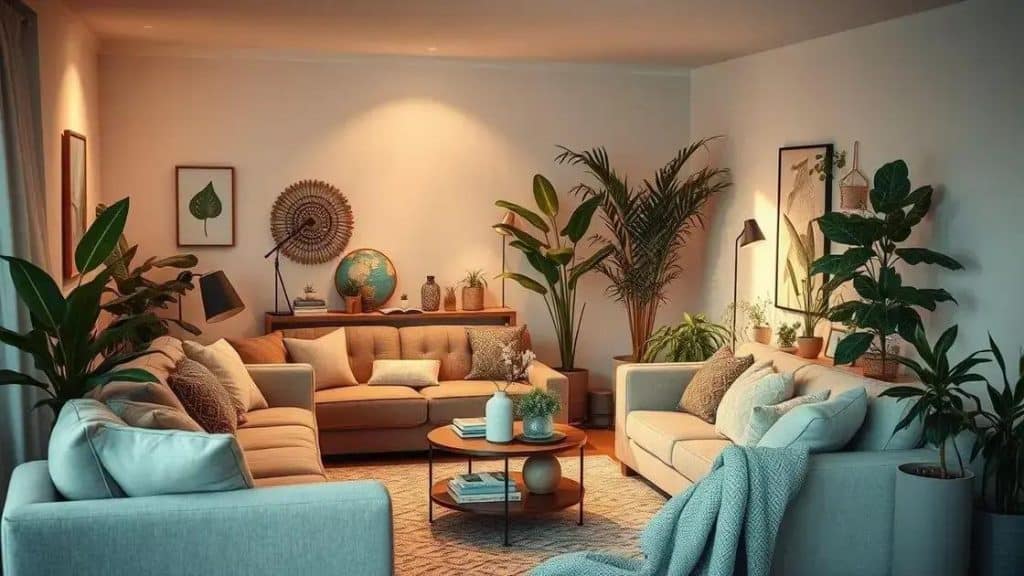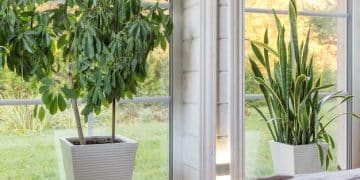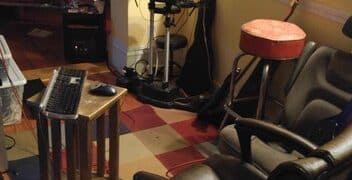Creating a clutter-free, peaceful home: 5 simple steps

Creating a clutter-free, peaceful home involves regular decluttering, utilizing creative storage solutions, incorporating natural elements, and practicing mindfulness to enhance your overall well-being.
Creating a clutter-free, peaceful home is essential for our well-being. Have you ever noticed how a tidy space can lift your mood? In this article, we’ll explore effective ways to simplify your surroundings and promote tranquility.
Understanding the impact of clutter on mental health
Understanding the impact of clutter on mental health is crucial for creating a peaceful home. Clutter can lead to feelings of anxiety and overwhelm, making it hard to focus or relax.
When we are surrounded by disorganization, our minds often reflect that chaos. Studies have shown that a cluttered environment can increase stress levels. This makes it even more important to manage our spaces effectively.
The psychological effects of clutter
Many people don’t realize how much their physical environment affects their mental state. Living in clutter can:
- Cause distraction and inability to concentrate.
- Lead to feelings of embarrassment or shame.
- Contribute to anxiety and depression.
By recognizing these effects, we can take steps to address clutter. A clean space can promote mindfulness and positivity, helping us feel more in control.
Creating a positive environment
A clutter-free space can significantly enhance our mental well-being. Incorporating organization methods can make a big difference. Here are some tips:
- Start small with one area at a time.
- Use storage baskets to keep items organized.
- Regularly assess your belongings to find what you truly need.
These simple actions can transform our surroundings, making them conducive to peace and clarity. Embracing minimalism can also be a wonderful strategy. It encourages us to focus on what truly matters.
By actively managing clutter, we pave the way for a more serene life. The benefits will extend beyond our homes and positively influence our mental state.
Essential techniques for decluttering your home

Essential techniques for decluttering your home can transform your living space into a peaceful environment. By applying these methods, you can make your home more organized and enjoyable.
The first step is to set clear goals. Determine which areas need the most attention. Focusing on small tasks, like one room at a time, can make the process less overwhelming.
Categorizing your belongings
Start by categorizing your items. This helps you see what you truly have. You can ask yourself questions like:
- Do I really need this?
- When was the last time I used this item?
- Does this bring me joy?
These questions can guide your decisions on what to keep and what to let go. Once you’ve categorized your belongings, you can create different piles: keep, donate, or trash.
Creating storage solutions
Next, consider creating effective storage solutions. Utilize storage bins, shelves, and organizers to keep items neatly stored. Furthermore, label everything to quickly find what you need. An organized space is less likely to become cluttered again.
Incorporate the principle of one in, one out. For each new item you bring into your home, try to remove one existing item. This approach helps maintain balance.
As you declutter, remember to manage your emotional attachments. It’s common to feel attached to items, but letting go can free up space and reduce stress. By focusing on the benefits of a clean home, you can stay motivated.
Remember, decluttering is not a one-time task; it’s an ongoing process. Make it a habit to regularly assess your belongings and maintain the organization.
Creative storage solutions for small spaces
Creative storage solutions for small spaces can make a big difference in maximizing your home’s potential. By using innovative ideas, you can transform cramped areas into organized havens.
Utilizing vertical space is key. Install shelves on walls to keep items off the floor. This not only creates more room but also adds a design element to your home. Consider using decorative boxes or baskets to organize your things while enhancing the decor.
Multi-functional furniture
Another great strategy is to invest in multi-functional furniture. For example, choose ottomans that open for storage or coffee tables with hidden compartments. These items provide both style and practicality, helping you reduce clutter.
Underutilized areas
Don’t forget about underutilized spaces. The area under your bed can hold seasonal items or extra linens. Use clear bins to easily find what you need. Likewise, consider utilizing the back of doors for storage. Hooks or over-the-door organizers make excellent use of that space.
Incorporate foldable furniture like tables and chairs that can be stored away when not in use. This flexibility allows you to adapt your living area according to your needs. When every piece in your home has a purpose, it’s easier to maintain a clutter-free atmosphere.
Lastly, decluttering regularly is essential. Regularly assess what you need and what you can let go. By being proactive, you can ensure your small space remains organized and functional.
Tips for maintaining a peaceful environment

Tips for maintaining a peaceful environment are essential for fostering a serene home. By incorporating simple habits and practices, you can create a calm space that enhances your well-being.
One effective approach is to limit distractions. Turn off unnecessary electronics and keep your space free from clutter. A clear area can help your mind stay focused and relaxed. Moreover, consider implementing a regular cleaning routine. Consistent tidying up prevents mess from piling up.
Incorporate nature
Bringing nature indoors is another fantastic way to create tranquility. Add plants to your space. They not only purify the air but also provide a calming effect. Choose low-maintenance varieties if you’re short on time.
Maintain a calming atmosphere
Additionally, lighting plays a crucial role in creating a peaceful environment. Use soft, warm lights in your home. Avoid harsh, bright lights that can create tension. Candles and fairy lights can add charm and coziness.
- Utilize soothing scents through essential oils or incense.
- Play soft music or nature sounds to enhance relaxation.
- Create designated quiet areas for reading or meditation.
Incorporating mindfulness practices can also improve your home’s atmosphere. Spend a few minutes daily engaging in meditation or yoga. This not only calms your mind but also centers your energy.
Lastly, surround yourself with meaningful items. Display artwork, photographs, or mementos that evoke happy memories. Positive reminders in your space can uplift your mood and foster peace.
In summary, maintaining a peaceful home requires simple yet effective strategies. By decluttering regularly and utilizing creative storage solutions, you can optimize your space. Incorporating natural elements and calming decor enhances tranquility. Remember that small changes, like adjusting lighting and practicing mindfulness, can have a significant impact on your environment. Create a space that reflects calm and serenity, supporting both your mental health and daily well-being.
FAQ – Questions about Maintaining a Peaceful Home
How often should I declutter my space?
It’s recommended to declutter at least once a month to keep your home organized and free from unnecessary items.
What types of plants are best for indoor spaces?
Low-maintenance plants like pothos, snake plants, and peace lilies are excellent choices for indoor spaces, as they are easy to care for and enhance air quality.
Can lighting really affect my mood?
Yes, soft and warm lighting can create a calming atmosphere, while bright or harsh lighting can lead to feelings of stress or discomfort.
How can I incorporate mindfulness into my daily routine?
You can start with just a few minutes of meditation or deep breathing exercises each day to help center your thoughts and promote relaxation.





